OM…OM…OM ... Sai Ram
With Pranams at the Lotus Feet of Bhagavan,
Dear Brothers and Sisters,
This is the third talk in which we will discuss Bhagavan’s recent trip to
Kodaikanal. As I have told you previously, today we will discuss what Swami said
there about great people like Adi Sankara and Sri Ramakrishna Paramahamsa, and
about certain devotees of the past, like Colonel Jogarao and Rajmata.
First, I would like to discuss a couple of things that Swami told us about the
Ramayana while in Kodaikanal. Then we can move on to what Swami had to say about
some of His oldest devotees.
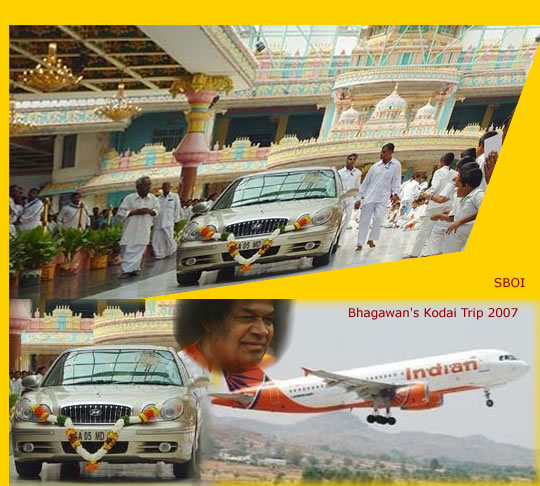 We need unity and friendship in today’s environment We need unity and friendship in today’s environment
Bhagavan mentioned a couple of episodes from the Ramayana, saying that these
should serve as ideals for all humanity. Kaushalya, Sumitra and Kaikeyi were the
three wives of King Dasharatha; interestingly, amongst the three, there was no
rivalry. They mingled as if they were sisters--Kaushalya, Sumitra and Kaikeyi.
There was never any competition between them, and they never fought. Swami said
that between them, there was perfect understanding. He further added that this
kind of amity, this kind of unity, this kind of friendship, is absolutely needed
today.
Lakshmana was always by Rama’s side, Shatrughna was always by Bharata’s side
In Kodaikanal, Bhagavan also discussed another important point regarding the
Ramayana. After the birth of Rama, Lakshmana, Bharata and Shatrughna, all four
of these children cried bitterly. King Dasharatha made every attempt to make
them happy, but failed utterly. Even all the top doctors from the whole of
Ayodhya were asked to come to treat these children; but their attempts were in
vain. Why these children were crying, no doctor could diagnose. Why the children
were restless, the mothers themselves did not know.
Finally Vashishta, the family priest, was asked to examine the children.
Vashishta said, upon closer observation, “Here is a very simple prescription:
Make Lakshmana lie close to Rama, in the same cradle, and make Shatrughna lie
very close to Bharata.”
All four children had been in different cradles. Instead, if Lakshmana were now
made to sleep beside Rama, and Shatrughna to sleep by Bharata, everything would
be okay, according to Vashishta. And so it was that the children were kept
together. Then all four were happy, and took their milk by the bellyful, playing
together and sleeping quietly together.
In discussing this, Swami said, “From then on, Lakshmana was always by Rama’s
side, and Shatrughna was always by the side of Bharata. That’s why
temperamentally, throughout their lives, they each followed their brothers.”
Swami went on to explain that the two, Lakshmana and Shatrughna, were born to
Sumitra. Why? Because Sumitra took half the share of the yagna payasam from the
sacrificial rites from Kaushalya, and the other half share from Kaikeyi. So, as
she had taken half a share from one and half from another, she gave birth to two
boys, Lakshmana and Shatrughna. Therefore, Shatrughna was the result of half the
share of the payasam his mother had taken from Kaikeyi. Hence, Shatrughna always
followed Bharata. Lakshmana was the result of the share she had taken from
Kaushalya; so Lakshmana always followed Ramachandra.
This was Swami’s explanation as to why all were very happy when together. Those
of you who are familiar with these names will be able to appreciate this story,
while to others this may seem quite alien, if not irrelevant. Anyway, that’s how
Swami quite ecstatically explained these episodes from the Ramayana and,
surprisingly enough, these secrets were not known to many of us.
We must be careful about where we live and who we spend time with
Next, Swami made mention of another episode from the Ramayana. Lakshmana
followed Rama, and normally followed Him in strict obedience, obeying whatever
Rama said, and following His every command. But after reaching Chitrakoota,
Lakshmana immediately started speaking oddly.
So what did he say? He said, “Brother, what is happening? Why should we be sent
to the forest? What harm have we done? Why did Kaikeyi want these boons granted?
Why?” Lakshmana seemed to be adamant and even defiant, as he went on questioning
like that.
Then Swami added something here. Listening to the comments of Lakshmana, Rama
said, “Look here, I can understand why you are talking like this. You were so
calm before, so reasonable, and you followed My commands obediently. It is only
now that you are questioning Me. It is not your fault. This is the path that was
inhabited by demons, and the path along which they trod. All demons pass by this
same path, and this path has its own influence. Therefore you are now defiant.”
That’s what Swami said.
This indirectly conveys a message that we must also be careful about where we
go. This teaches us that we must be careful about where we spend our time, and
with whom. The people amongst whom we socialise and the places in which we spend
our time will naturally influence us with certain vibrations, which will affect
our psychology and our behaviour. That’s why we have to be careful. That’s what
Swami said.
The place trodden upon by demons induced Lakshmana to defy Rama’s command. This
only means that we have to take care about the place that we choose to live. It
is not that there is some better accommodation or some better place to live,
where we should attempt to start our lives anew. It is that the people around us
and the places where we choose to live are very important in terms of their
vibrations. That is the message Swami gave us in telling this particular story.
Ravana treated sita wih reverence and respect
Baba also said in Kodaikanal that Ravana was a great man. Ravana, a good man!?
That surprised me! If Ravana was good, I don’t know who is bad in this world! If
Ravana was a good man, we must all be sages and saints, the greatest people on
earth! Usually Ravana is known as the consummate villain, who kidnapped Mother
Sita. There cannot be any sin worse than this; yet Swami said, “Ravana was a
good man.”
If this is so, which it must be as Swami said it, then where is the bad man here
today? I could not understand this, and so I immediately responded, “Swami, only
You could say that Ravana was good. Nobody else would say that. Bhagavan, in
Your stories and descriptions, You have Your own unique style. You never
characterise any role, any part or any character as low. No! You elevate all to
sublime heights. There is never a villain in Your stories. That surprises me.
But I don’t know why You would say that Ravana was a good man.”
So then Swami said, “Ravana was a good man because, although he kidnapped Sita,
he did not touch her. He never touched her. Sita stayed there for ten long
months; all that time he treated her with reverence and respect. Secondly, she
was not taken off physically, dragged along the ground from where she was
staying. She was transported. Even when she was taken from that place, he didn’t
touch her. So how can you say that Ravana was bad?”
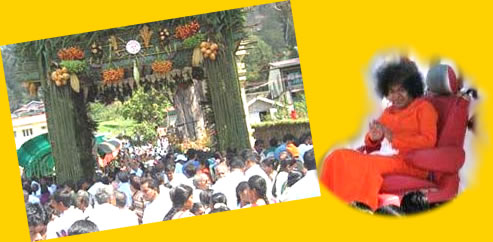
RAvana Kidnapped Sita to die at the hands of Rama
Furthermore Baba said, “Unless Ravana had kidnapped Sita, Rama would not have
been angry with him.” Rama was not a petty person, who would fight for every
silly thing, as modern politicians do. In Ravana’s case, however, dharma had to
be re-established. When dharma has been lost, as it was a serious issue indeed
to kidnap Sita, serious measures had to be taken. So to re-establish dharma,
Rama was prepared to wage war against Ravana. In order to see to it that Rama
was angry, Ravana had kidnapped Sita.
Why did Ravana want Rama to be angry with him? In order to die by Rama’s hand!
Ravana wanted to die at the hands of Ramachandra. He was very much willing to
die by His hand. Why? Why should you try to die? That will happen automatically,
naturally. One need not try to die. If one tries to die, it is suicide. Well,
the answer to that is that he wanted to die by Rama’s hand.
Then Bhagavan explained why he had this desire. He said, “Ravana had been doing
door duty in Vaikunta, in paradise. He was a seva dal there, a man standing
watch at the door of Sri Maha Vishnu. Because of Ravana’s arrogance (the same
arrogance as you find amongst most people today), he was cursed to be born like
this, to be born as a demon. After receiving this curse, Ravana fell at the feet
of the sages asking, ‘Swami, how is it that you have cursed me like this? I
cannot be away from my God!’ “
“Then sages said, ‘By being a demon, you will fight with God in human form, and
you will die at His hands. Only then can you come back to your seva dal duty!
(Laughter) Only then you will come back to your door duty.’ That’s what Bhagavan
told us.
Therefore, Ravana’s only desire was to regain his position as a guard at the
doorstep of Sri Maha Vishnu in paradise, in Vaikunta. Therefore, how can he be
bad? He had to commit these crimes because he could not bear the pangs of
separation from Vishnu. He wanted to be in His company, and therefore he did
this.
Truth needs no justification
I said, “Swami, what a wonderful justification that is!”
Swami said, “It is not a justification. It is the truth. Correct your English!”
(Laughter)
Truth and justification are different; you have to justify that which is not
true. “This is truth, I am not justifying. You fellows just do not know the
truth here.” That’s what Baba said.
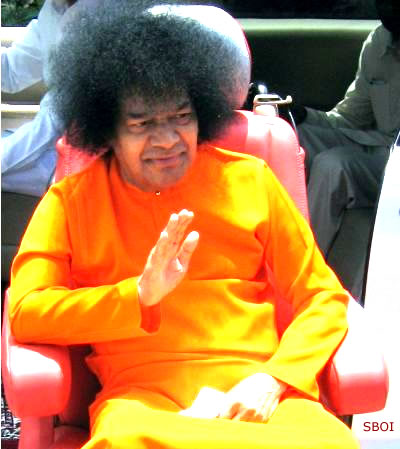 Therefore, when Swami explains the Ramayana, He takes the analysis to altogether
different heights. Therefore, when Swami explains the Ramayana, He takes the analysis to altogether
different heights.
Manthara As a faithful Servant
Manthara also came up in Kodaikanal. You’ve heard of Manthara?! Manthara
symbolises hatred incarnate and envy personified. This Manthara had a very bad
role to play in the Ramayana. If I call any lady ‘Manthara’, she would
definitely not take it kindly. She would probably give me one or two slaps!
(Laughter) She would finish me off! So Manthara is not a good name to have. No
woman would like to have the name ‘Manthara’, just as no man would like to be
called ‘Ravana’.
If I call anybody ‘Ravana’, he would immediately say, “I would like a word with
you!” (Laughter) Who would be crazy enough to want to be called ‘Ravana’?
Likewise, it is also a shameful thing to be called ‘Manthara’. Therefore,
Manthara is bad as she represents envy and pride. Or so we think.
But our good God says, “No, no, Manthara was a good lady.” (Laughter)
“What is this? Swami, if Manthara was a good lady, then there are none in this
universe who are bad. If this is so, then all ladies are good!”
Then Swami said, “Manthara reminded Kaikeyi of the boons that she had taken from
Dasharatha. Dasharatha had granted boons to Kaikeyi, and Manthara only reminded
her of those boons. That’s all she did. Who granted those boons? Dasharatha. And
to whom? To Kaikeyi. What has Manthara got to do with it? Nothing. So how can
you say that Manthara is bad? She’s not bad! She just reminded Kaikeyi.”
“Swami, what sort of reminder is this?! Is it a healthy reminder? Why should she
remind her of such a bad thing?”
Then Swami responded, “No, no, no! Manthara was a very good lady. Why? She was
Kaikeyi’s servant. Being a servant to Kaikeyi, Manthara had to look after
Kaikeyi’s interests. Her father had sent her to serve Kaikeyi, so Manthara
served dutifully. It was Manthara’s duty to remind her mistress of that which
she had forgotten. Manthara was simply reminding Kaikeyi. Manthara made no
mistake. The mistake was actually Dasharatha’s, not Manthara’s.”
“Oh, I see Swami. Then, Kaikeyi was bad. Why should she ask that these boons be
granted then?”
Baba said, “No, no! She was a good lady too.”
“Why?”
So Baba explained: “Dasharatha had said, ‘Ask for anything and I’ll give it to
you.’ So she asked for those things, and he granted them. He basically gave her
a blank cheque. She then dated it and cashed it. She simply asked for her boon,
and he granted it. He had never mentioned how or when. He didn’t tell that. He
simply had said, ‘Yes.’ She said, ‘Alright, you told me a long time back that
you would grant me these boons; so, come on now and give them to me,’ So neither
was it her mistake.”
According to Swami, no role played out in life is low or mean or bad. Having
been born in this country, many of us here must have heard this sacred mythology
repeated (because we go to temples frequently in India). Therefore, despite
having heard this story repeatedly, I am still sure that none of us have ever
come across this kind of interpretation. It is only Baba who teaches the story
in this way. These are things that only Swami says about the Ramayana.
Paramhansa chose Brahmananda due to his BALANCED STATE OF MIND
I would also like to bring to your attention a few of the statements that Swami
made concerning Sri Ramakrishna Paramahamsa.
Swami said, “Though Paramahamsa had many disciples, two in particular were very
important: Vivekananda and Brahmananda. We always think that Vivekananda was
greater than Brahmananda, but actually Sri Ramakrishna Paramahamsa had a special
fondness for Brahmananda. Why? Vivekananda embodied a rajasic quality, an
emotional, sentimental nature, which made him prone to emotional outbursts,
whereas Brahmananda was known for his sathwic quality, his pious, balanced state
of mind. He wasn’t prone to losing his balance like Vivekananda.
So when we ask, “Why did Ramakrishna Paramahamsa make Brahmananda the head, and
not Vivekananda?” Swami answered, “Because of his temperament, his balanced
state of mind.” That’s what Baba said. Brahmananda remained consistently
steadfast. He had chitta pradnya. He never lost his balanced state of mind.
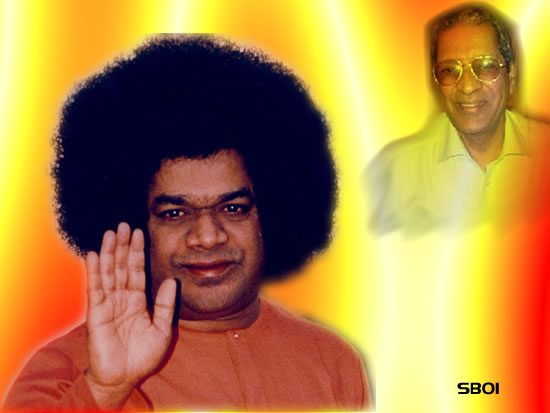
Never give others a chance to comment upon your character
Brahmananda also never gave an opportunity for anybody to criticise his
character or to comment upon his integrity. His conduct was such that there was
nothing that the public might seize upon to criticise in his character or
question about his integrity. This point is important for all of us to hear.
Someone asked Baba, “Swami, You have taken action against me. You know that I am
not at fault but, just because somebody reported it, You have taken action
against me. However, You know the truth. So why should You take action against
me?”
Baba replied with a statement that is important for all of us. What did Swami
say? “Gentleman, it is necessary that you be good, and it is equally necessary
to look good. You should be good, and you should also look good.”
What does ‘look good’ mean? Does it mean to dress neatly? No. It means that you
shouldn’t leave any room for others to comment upon your character, performance
or integrity. In this respect, Brahmananda was certainly greater than
Vivekananda. That’s what Swami had to say about Ramakrishna Paramahamsa’s
biography and mission. It is an aspect with which we may not have been familiar,
I am sure.
For Shirdi Sai Baba, it was enough that you came to him
Bhagavan also made reference in Kodaikanal to Shirdi Maharaja, Shirdi
Bhagavan–His previous Incarnation. Naturally, as we think of Shirdi Bhagavan, we
become quite excited. Shirdi Bhagavan acted like a typical grandfather. No one
needed to demonstrate any special traits to gain his favour. Whether one did
sadhana or japa or seva, none of these had any impact on Him!
If anyone came to Shirdi Bhagavan, He considered it His duty to fulfil their
desire. That’s all. He felt that if you had come to Him, if you had prayed for
something, then that was enough. He did not check to see how much service you
had done previously. He did not investigate the good or the bad you had done
during this life or during a past one. All of this was of no concern to Shirdi
Bhagavan. It was very lovely when Swami spoke of Shirdi Bhagavan!
THE Lifestyle of THE Avatar is in tune with the times
Somebody asked Baba, “Swami, how is it that Shirdi Bhagavan wore such an
unattractive dress?” Pictures show that Shirdi Bhagavan wore old, tattered
clothes. So I wondered how Baba would respond to this question.
People here are so religious that if Swami were to say that old, torn, tattered
clothing represents the correct way to dress, then everybody would arrive that
afternoon for darshan in such an outfit! In that case, torn, worn-out clothes
would sell like hot cakes here! (Laughter) Fellows are like that here!
Well, do you know what Baba said? He said, “The style of an Avatar will be in
tune with that of His contemporary society. Shirdi Bhagavan dressed in a way
which was suitable and appropriate for His time and for the place where He
lived.”

Shirdi Bhagavan lived in a village, one that was very rustic. There was constant
rivalry there between Hindus and Mohammedans. In a small village, people often
did not know how to live together. There, Hindus and Mohammedans were constantly
fighting with each other. So Shirdi Baba’s mission was to foster friendship and
a sense of togetherness between the Hindus and the Muslims. So He led His life
according to the mission and purpose which He had set for Himself.
Shirdi Baba was omniscient and omnipresent
Swami also told other stories about Shirdi Sai’s life. In one, it seems that
there was one devotee who once came to Shirdi Bhagavan and tried to touch His
feet. When he did this, Shirdi Baba asked, “Why did you do that? You already did
padnamskar earlier. Why do you want to do it again? Why do you want to repeat
it?”
And the devotee responded, “Bhagavan, what are You saying? I have come only just
now. Why do You say that I am taking Your padnamskar for a second time? I have
only come just now to You.”
Then Shirdi said to him, “Before starting from your home in Bombay, you did
namaskar to My photo. I know that. Therefore, I asked why do you want to repeat
it for a second time.”
This story illustrates Shirdi Bhagavan’s omniscience and omnipresence. He knew
of everything that was happening everywhere, because He is everywhere. Bhagavan
explained this episode so beautifully.
God is present in all beings
Baba then described another episode from Shirdi Bhagavan’s life, saying that
nobody ever knew in what form He would come to visit them. In fact, one lady
invited Shirdi Bhagavan for lunch. Swami said, “Why not? I will come.” But He
did not come.
The lady later went to Shirdi Bhagavan and complained, “Swami, I waited for You,
but You did not come. I prepared for You a delicious meal, including the sweets
that I know You like; but You did not come. Why did You not keep Your promise?”
Then Baba said, “I did come.”
“You came? You never came!” said the lady. “Swami, why do You tell lies like
this?”
Shirdi Baba then replied, “Whatever I say here is dwarkamayi—nothing but truth.”
“Now you are speaking lies! What is this?” asked that lady.
So Shirdi Bhagavan then showed her His back where there were striped marks.
“Swami, what are these stripes on Your back? What is this? Who has beaten You?”
So Baba told her, “I came to your house this afternoon in the form of a buffalo.
I came very close to your house, but you beat this buffalo, and that created
those stripes on My back!”
Another time, another lady invited Shirdi Bhagavan for lunch and Swami accepted;
but again He seemingly did not turn up. So later the lady asked Him, “Why didn’t
You come?”
Swami replied, “I came, but you drove Me out!”
“I drove You out?! After having invited You? I didn’t do that, Swami! Why do You
speak like that?”
Then Shirdi Bhagavan said, “I came in the form of a dog, but you chased Me out.
You did not recognise Me.”
Swami thus explained that God could come in an infinite multitude of forms. How
then can you recognise Him? Well, tough to say, because God can come in any form
He wants, in any moment. Iswara Sarva Bhutanam: “God is present in all beings.”
Vasudeva Sarva Bhiti: “God dwells everywhere.” This is the lesson that was given
us by Baba during one of His conversations about Shirdi Bhagavan’s life.
For Shirdi Sai Baba’S ANSWER TO A MAN’S REQUEST FOR MOKSHA
Baba also spoke of an incident in which a person came to Shirdi Bhagavan and
said, “Swami, I want the path of liberation, the path of moksha.”
A very good request, yet Swami turned a deaf ear to this request, as does Sai
Baba even now to some of our questions. It’s the same thing! Do you see that?
The same action replayed and repeated! (Laughter) So then, what happened?
Suddenly, Shirdi Bhagavan asked another man, “Please go to a certain fellow’s
house and get five rupees from him.”
The man went off to find the other man, but later returned saying, “Swami, I
went there, but the person whom You wanted me to contact was not there.”
“I see,” said Swami. “Okay, then go to this other fellow’s house to get the five
rupees.”
Again the man went as asked, but soon returned telling, “Swami, that fellow also
was not there.”
“I see. Well, then go to this other fellow’s house and get the five rupees from
him.”
Like this, Shirdi Bhagavan went on asking this man to visit the residences of
two or three other people; but the man always returned saying they were not
available.
Finally Baba turned toward the man who had sought liberation. “You want
liberation. You have got enough money in your pocket. When I sent this person
for five rupees, you could not take a five-rupee note out of your pocket? A
fellow who could not spare five rupees wants moksha? How is that possible? You
are not prepared to sacrifice five rupees because you consider five rupees more
valuable than moksha, than liberation.”
Our Swami told us this. Therefore, my friends, Swami mentioned these episodes
during the course of His conversations there in Kodaikanal. These stories are
indications, are cautions, are teachings for everybody who is privileged enough
to hear His thoughts and conversations which took place there.
one should NOT look down upon KARMA OR BHAKTHI
Swami also spoke in Kodaikanal about Adi Sankara. Swami said that just because
Adi Sankara was known as a proponent of Advaita (non-dualism), that does not
mean that he ignored other aspects of spirituality. Adi Sankara established
mutts or centres for discussion of Advaita, at four different locations in
India. He also travelled all over the country teaching. That is karma yoga, or
the path of action. Adi Sankara also composed many hymns in appreciation of
Mother Sharada, in appreciation and adoration of the Mother goddess. That is
devotion, or the path of bhakthi.
Adi Sankara himself is the founder Advaita (non-dualism). So, practicing
non-dualism does not mean that one should look down upon karma yoga, the path of
action, or bhakthi, the path of devotion. In Adi Sankara, we find the perfect
combination of karma, bhakthi and jnana.
That’s what Swami explained so beautifully: All these three are integrated, one
path leading to the other. They are complimentary paths, not opposites or
contradictory. Otherwise, we tend to think that Adi Sankara represents Advaita
only and nothing else. But it is not so. That’s what He explained about Adi
Sankara during His stay in Kodaikanal.
Rajmata Had the highest devotion for Baba all her life
Then Swami spoke about some of the devotees from the olden days. Swami mentioned
the Rajmata of Navanagar, praising her devotion. Most of you must have heard her
name, as she is an old devotee of Bhagavan.
She is a soft lady, a very intelligent lady, a lady of sacrifice and a lady of
knowledge, particularly in the fields of law and Ayurvedic medicine. She is a
very wise lady. She had the courage to say ‘no’ to Jawaharlal Nehru, the Prime
Minister at that time. She embodies courage and strength. She has a masterful
knowledge of Indian medicine, and she has immense devotion for Bhagavan.
I am reminded of what happened in Brindavan long ago. On the dais in Brindavan,
you must have seen the big idol, the large bronze statue of Sri Krishna. On the
day that that statue arrived in Brindavan, as it was being transported from a
van into the hall, Swami asked me how I liked it.
“Swami, it is a most beautiful statue.”
Then Swami asked the warden, “How do you like it?”
“Swami, it is excellent, wonderful, and very beautiful!”
Rajmata was also there, so Swami then asked Rajmata, “How do you like it?”
Do you know what she said? “It is not as beautiful as You, Swami.” (Laughter and
applause) “It is not as beautiful as You are. To me, nothing is more beautiful
than You, my Sai Krishna.” That’s what she said.
When I reminded Swami of this, He said, “Rajmata always thought of Me like that.
She was that devoted throughout her life,” said Bhagavan.
Then He recalled His stay in Navanagar and Jamnagar. When he was there, it seems
a big trolley, piled with plates with a hundred sweets, was brought to Swami.
She said, “Swami, this is for Your breakfast.”
Swami said, “I am not going to eat all this. Why all this? Why do you bring all
this?”
“But Swami,” she said, “it is a royal tradition, the royal style of
presentation. You can just taste a bit and then leave it. Taste it and leave it.
That’s all. That will then become the prasadam to be distributed to everybody.”
That’s what she said.
Swami also praised her intelligence, remarking that she grew medicinal plants
near the palace, which were of great value in Indian medicine. Swami had great
praise for her intelligence and her devotion.
Ramakrishna Rao was a great devotee
Swami also mentioned Veer Ramakrishna Rao, Gurukula Ramakrishna Rao, a great
devotee and a matchless man. I can say that he is second to none. He is very
small in his stature, and Swami always loved to joke with him.
Swami once said to him, “Ramakrishna Rao, who is the taller of us—you or Me? Am
I taller than you, or are you taller than Me?” (Laughter)
Ramakrishna Rao, a great devotee, said in all humility, as he bent with folded
hands, “Swami, You are taller than me.”
Baba would said, “No, no, no! You are taller than Me. Because of My hair, I look
taller than you, but actually you are taller than Me!” (Laughter) This is now
what they say to each other every time they meet!
Ramakrishna was also lucky enough to have followed Swami as He toured India. In
fact, he was instrumental in arranging Bhagavan’s tour of India. When Bhagavan
went to Rishikesh and Badri, the whole trip was planned by Ramakrishna Rao, who
was the Governor of Kerala then. He is also fluent in fifteen languages, such a
great scholar he is! Swami always refers to Ramakrishna Rao with great
appreciation.
PurUshotamananda had waited in penance for Swami all his life
When Swami visited a cave in North India near Badrinath, He suddenly asked
everybody to wait outside while He went in. “Don’t follow Me in here. I alone
will go in,” He announced.
So He entered that cave near Badrinath alone, and there He met Purushotamananda,
a great saint of those days. Purushotamananda was in deep penance, waiting for
the arrival of Bhagavan. The moment Swami arrived, Purushotamananda understood
that before him was the manifestation of Divinity, to whom he had been praying
throughout his life!
Then Swami spoke to him. Everyone else was watching from outside because Swami
had told them, “Stay there. Don’t come in.”
They all watched while Swami spoke to Purushotamananda and materialised a
photograph and presented it to him. Then Purushotamananda put Swami’s photograph
on his chest. From that day onward, he told everybody, to all his disciples, “If
you want to see God, if you want to experience God, He is none other than
Bhagavan Sathya Sai Baba!”
Swami is not the body
Swami spoke at some length about His North Indian tour, and how people followed
Him. Everybody wore warm clothing on the trip—sweaters, gloves and socks; but
Bhagavan walked through the Himalayas without any sweater, shawl, slippers, or
even shoes on His feet! We could never dream of doing this!
Swami was able to do this because He is not the body. Sometimes we mistakenly
believe that He is the body because we are so close to His body and are
privileged to have His darshan both morning and evening. But He is not the body.
How do we know? Come on! You try to walk barefoot on ice—impossible! And He
didn’t even wear any banyan, just a dhoti underneath! That’s all!
Walking in the cold, Swami told, “Itlane vellanayya”: “I am like this.” He also
said, “Yemi naku akkarledu”, meaning, “I don’t need.” He said, “Extra emi ledu”,
meaning “I don’t have any extra dress.”
When He told us this, I asked Swami, “Did they carry any food along with the
party, as there were so many people along?”
He explained that all were very comfortable. Eswaramma was also in the party.
“Yes, yes,” He said, “we had lorry-loads of pickles and all sorts of things for
everybody to eat!” That’s how Swami described the trip in the Himalayas with
Gurukula Ramakrishna Rao.
Ramakrishna Rao - a great poet
I remember one sentence from a poem composed by Ramakrishna Rao, a great poet:
Ni kutilalaka bhramul lalanaseyu, bhagya laalasul…
Yes, there is a poem composed by Ramakrishna Rao. From it, this is a sentence I
will always remember:
Ni kutilalaka bhramul lalanaseyu…
He is saying, “Oh dear God, You are adjusting Your hair. You adjust Your hair in
such a lovely way. Those people who witness You adjusting Your hair are bhagya
laalasul, very fortunate people.”
Palanasetu yallara krupa matin…
“You take care of them. Through Your grace, You bless them.”
Who are ‘they’? Those people who watch You adjusting Your lovely hair.
Swami was very happy and He said, “What about other three lines?”
I had to admit, “Swami, I don’t remember them.”
Then Swami started quoting the whole poem composed by Ramakrishna Rao some 60
years before. 60 years ago! Then Swami explained the poem for the benefit of the
people who do not know the Telugu language.
The poem says that His hair is like a cloud, like a crown. That was how
Ramakrishna Rao described Swami’s hair. I was so happy to hear Swami quoting
Ramakrishna’s poems and explaining them to us all.
Raja Venkatagiri’S DEVOTION
Swami also spoke of the Raja of Venkatagiri. The Raja has also had an important
place in Sai’s life. The Raja has a big build and a personality to match. He has
a hefty build. He is over six feet tall, plus he has an equally large
personality. He was also a staunch devotee, and he used to visit Parthi
frequently. Being a raja (king), he was always accompanied here by two escorts,
one on either side.
One day, while he was walking in the hills here, a village boy who was tending
sheep approached him. The boy did not know that he was a raja and came very
close to him, asking, “Do you have a beedi?” (Laughter)
Do you know what a beedi is? I didn’t know. It is not a cigarette. A beedi is a
tobacco leaf made into a cigarette-like thing. Anyway, the Raja answered, “I
don’t smoke.”
And to that this village boy said, “Em gadidha madiri vunnavu, bidi kalchadam
chetha kaada?” (Laughter)
This boy said, “You are this big, this large a build, and you don’t know how to
smoke?! What is your big body good for then? You are over six feet tall and you
don’t know how to smoke? You have wasted your life!” (Laughter) That’s what that
village boy said, laughingly as he spoke to this raja. He was such an innocent
boy!
The Raja of Venkatagiri was such a staunch devotee that whenever Swami visited
Venkatagiri, on the final day, when Baba would leave in His car, this Raja of
Venkatagiri would roll on the ground so that the dust kicked up behind Swami’s
car might touch his body. The Raja would roll on the ground because it was the
land on which God had moved. This soil had touched the Feet of God, so he
thought, ‘Let that dust touch my body.’ It made Swami very happy to remember and
speak of the Raja of Venkatagiri.
Only god knows his ways of functioning
Swami also discussed Colonel Jogarao with us. Most of you must have seen
Jogarao.
One day, Swami announced that Anantapur College was soon to be ready, and that
it would be inaugurated shortly. Colonel Jogarao, however, as a member of the
Central Trust, knew that there was not enough money in the Central Trust’s
accounts to complete the project; yet Swami was saying that the college would be
ready very soon.
So knowing that the Central Trust didn’t have the money to cover what Swami had
promised, Jogarao could not sleep that night and his blood pressure shot
straight up.
The next morning Swami asked Jogarao to join Him at breakfast. He looked deeply
into Jogarao’s eyes and told him, “Jogarao, it was I who announced that. Why
should you allow your blood pressure to shoot up like that? (Laughter) Why
should your BP go up? I announced it, so why do you worry so?”
To that Jogarao replied, “Swami, there is no money in the accounts to proceed
with the project, so I was feeling badly that You had made such an
announcement.”
But Swami said to him, “Hey, don’t worry. It’s My duty! I’ll take care of it.”
Later that same day, when Jogarao went to the bank, he found hundreds of crores
deposited in the Central Trust account!
When he then saw Swami again, Baba laughed and said to him, “Only God knows His
ways. Only God knows how He will achieve His aims. You cannot come to any
conclusions. You don’t need to be afraid of God’s plans. Only He knows His own
ways, how to fulfil and keep His promises.” That’s the story that Swami told us
about Jogarao.
Swami frequently joked with Ramabrahmam
Swami also discussed Ramabrahmam with us. Ramabrahmam used to be the caretaker
of the Whitefield campus in Bangalore. Once, in the early hours of the morning,
he heard a tapping at the window.
When he opened the window to see who was there, he saw Sai Gita (Swami’s pet
elephant) standing outside, her trunk up in the air. When Ramabrahmam saw this,
he started shaking, his whole body moving as if doing a dance. (Laughter)
“Swami, Swami!” he called out.
“What happened?” Swami inquired.
Ramabrahmam continued, “Swami, Sai Gita has come here. Sai Gita has raised her
trunk, Swami, and she is coming through the window into the Mandir! What am I to
do?”
Swami said, “Don’t worry. She left Puttaparthi and just started running, all
alone! She has just now reached Brindavan. Don’t worry. I’ll go and calm her.”
Then Swami opened the door, and fondled and caressed Sai Gita, pacifying her and
putting her at ease.
Swami was also very free with Ramabrahmam in the way that He used to joke with
him. One day Swami called Ramabrahmam in and said, “Tell everybody that there is
no darshan this morning.” (This was unheard of in those days.)
So Ramabrahmam came out of Swami’s abode in Brindavan and walked toward the Sai
Ram Shed, where there were thousands assembled for morning darshan. He told
everybody, “Sai Ram. There will be no darshan this morning.”
Having said that, he turned around. Much to his surprise, he saw that Swami was
directly behind him! (Laughter) So, what did Swami do? He said, “Ramabrahmam!
Out!” (Laughter)
Poor Ramabrahmam, this poor fellow, then lost his balance. As Swami told this
story, He laughed like anything. It was a very funny story, and lovely to hear
how Swami would joke with Ramabrahmam.
One time Swami instructed Ramabrahmam, regarding a very well know V.I.P: “Don’t
permit him into the Mandir. Don’t allow him in, but do not say that he is not
allowed in.”
That man used to always join Swami at His breakfast table, His lunch table, and
His dinner table. So this V.I.P. always spent a lot of time with Swami; but
suddenly, Swami instructed Ramabrahmam not to let this man in! What was poor
Ramabrahmam to do?
The next morning, that man came to the building to enter. Now, how can
Ramabrahmam not allow him in, but not say that the man is not allowed to enter?
So what Ramabrahmam did was to simply say, “Sai Ram!” (Anil Kumar gestured with
his arms outstretched.) (Laughter)
He didn’t say, “You are not allowed.” He didn’t say, “Get out.” He only said,
“Sai Ram!” So this happened to this VIP for three days.
On the fourth day, Swami came and, seeing that gentleman in the darshan lines,
asked him, “What happened to you all these days? Are you not coming for darshan?
Ramabrahmam, why didn’t you permit him to go into the Mandir? Useless! I’ll send
you out of the Mandir! That’s not how you are to behave!” (Laughter)
All poor Ramabrahmam could say was, “Sai Ram.” That’s all. (Laughter) He had
nothing else to say other than, “Sai Ram.”
Love of Bhagavan is unparalleled
When Swami was angry with Ramabrahmam, He used to tell him, “Get out of the
Mandir right now. Get out!”
Ramabrahmam would then have to pack his bags and leave the ashram. He was sent
out of the ashram thirteen times in all! (Laughter) So he would come out of the
Mandir with all of his baggage; but then what would he do? He’d put his entire
luggage outside the Mandir and then sit in front of that gate where Swami could
see him through the window. Other people would come by and watch him too,
because Ramabrahmam was a very important caretaker, and very close to Swami.
So other VIPs would see him and say, “Ramabrahmam, what happened to you? Sir,
why are you sitting here?” (Laughter) (Anil Kumar enacted Ramabrahmam’s
response) That was his standard reply to everybody. He was a topmost man like
Indulal Shah.
“Ramabrahmam, why are you sitting here?” everyone would ask.
During this, Swami would watch Ramabrahmam through the window. Ramabrahmam would
sit there outside the gate all day, with some strong peppermint in his pocket,
so that he wouldn’t have to get up for water. Then, when bhajans would finish in
the evening, Swami would call to him through the window, “Hey Ramabrahmam, come
on! Why are you sitting like that?”
And Ramabrahmam would say, “Swami, You asked me to get out of the Mandir.
Therefore, I am sitting with the other devotees.”
And Swami would ask, “What about your lunch?”
He would reply, “Swami, I didn’t have any lunch.”
Then Swami would say to him, “Ramabrahmam, when you didn’t have any lunch, how
can you think that I’ll have taken lunch. I, too, didn’t have lunch. So, come
on. Let’s eat lunch together now.” And with that, He’d take Ramabrahmam for
lunch. (Applause) This is the love of Bhagavan for His devotees.
Swami’s concern for his devotees is highest
One time, Swami told Ramabrahmam, “Ramabrahmam, your wife is shouting. This
whole place is otherwise so silent; but I constantly hear your wife’s voice. It
is disturbing.”
“Yes, Swami,” he said.
So what did Ramabrahmam do? He asked his wife to leave, to go to her village and
stay there, to leave Brindavan, Hari Om! He actually asked her to go because of
what Swami had said.
And the next morning Swami asked him, “Where is your wife?”
“Swami, I sent her home.”
Swami asked him, “Why? Did I ask you to do that?”
“Sai Ram,” was all that Ramabrahmam could say. (Laughter)
The next day, Swami asked Ramabrahmam again, “Where is your wife?”
“I don’t know, Swami.”
“Where is your wife?” Swami went on asking every day and warned him, “Bring her
back or I’ll send you away too. I’ll send you out to bring her back.” That is
the level of concern Swami had for His devotees.
Swami BROUGHT RAMABRAHMAM’S son back to life
I can also tell you one more thing relating to Ramabrahmam. One day Swami called
Ramabrahmam and said, “Ramabrahmam, your son is no more. Don’t tell your wife
now. Just take her to your village. Don’t tell her anything about this while on
the way.”
So Ramabrahmam and his wife went to their village and saw their son’s dead body.
The following day, they came to Swami and his wife cried, “Swami, why have You
taken him like that? He was a young man, and now he is no more. What have You
done?”
Swami said, “He reached me.”
Ramabrahmam’s wife then said, “But that is not enough. He should be with me. It
is not enough that he reached You! That will not satisfy me.”
She continued crying, and then Swami asked the couple to go into the interview
room. When they did, they saw their son sitting there. They saw their son who
was no more—yet they could now see him, alive in the interview room! This story
was told by Bhagavan Himself while in Kodaikanal. Swami Himself said, “They
could see their lost son in the physical body, flesh and blood, right in front
of them!”
Devotees of the past continue to be our guides
This Kodaikanal trip was quite different from the past Kodaikanal trips in that
Swami spoke a great deal about former devotees, devotees from the past who
continue to serve as ideals for us. If we are to learn, we have to learn from
them. They are not like the devotees of these days. They faced all kinds of
challenges and troubles, and they withstood the tests of Bhagavan and emerged
successful. For this reason, they continue to be our guides.
Thank you very much for your time. Though the public address system failed, as
it often does, still I appreciate your patience in being with us this morning.
Now we have completed the three episodes relating to Bhagavan’s Kodaikanal trip.
May Bhagavan bless you! Thank you very much.
OM…OM…OM…
Asato Maa Sad Gamaya
Tamaso Maa Jyotir Gamaya
Mrtyormaa Amrtam Gamaya
Om Loka Samastha Sukhino Bhavantu
Loka Samastha Sukhino Bhavantu
Loka Samastha Sukhino Bhavantu
Om Shanti Shanti Shanti
Part I -
Part II -
Part III |

 We need unity and friendship in today’s environment
We need unity and friendship in today’s environment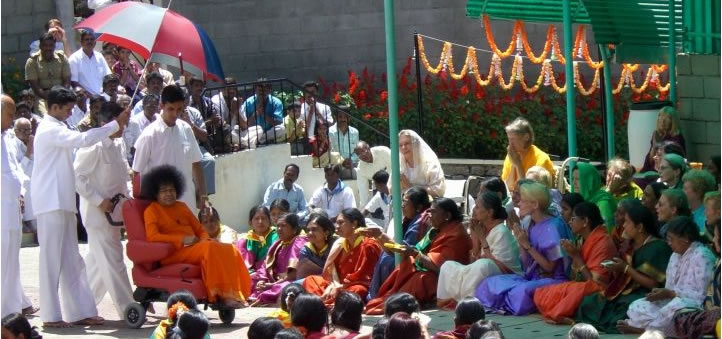
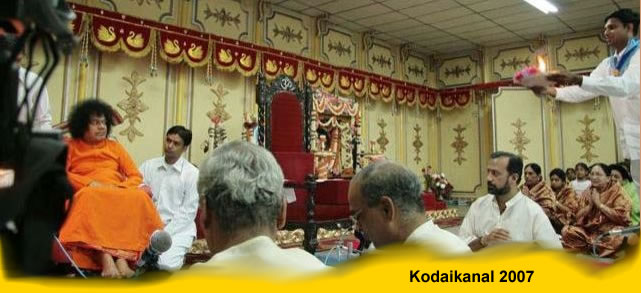

 Therefore, when Swami explains the Ramayana, He takes the analysis to altogether
different heights.
Therefore, when Swami explains the Ramayana, He takes the analysis to altogether
different heights.
